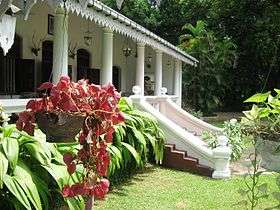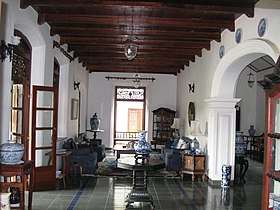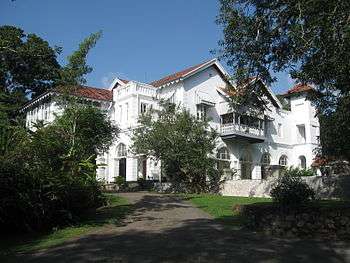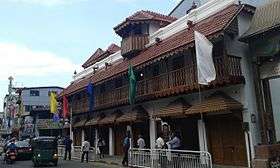Walauwa
Walauwa or walawwa is the name given to a feudal/colonial manor house in Sri Lanka of a native headmen. It is also refers to the feudal social systems that existed during the colonial era.
The term walauwa is derived from the Tamil word valavu, which denotes a compound or garden, and by implication, a large house with aristocratic connotations. The pinnacle of walauwas in the Sinhala social stratum is the wasala walauwa. Wasala is derived from the Tamil vaasal, which means an entrance. In the Sinhalese social hierarchy, a wasala walawa would typically be the ancestral residence of a mudaliyar.
Walauwas vary in style, elegance and uniqueness depending upon the financial resources of the individual families and in the village or area's social structure. Most walauwas tend to incorporate aspects of traditional pre-colonial Ceylonese architecture, as well as Dutch and later colonial influences. A walauwa usually consisted of a cluster of buildings linked by verandahs, with an internal courtyard (medamidula), which separated the private life of the family from the headman's public duties.
The walauwa were traditionally associated with the homes of the courtiers (radala), members of the royal court in Kandy. It was displaced by their colonial equivalents following the dissolution of the Kingdom of Kandy by the British.[1][2]


Rambukkana, Sri Lanka


Kandyan Walauwas
There were 18 main walauwas in the Kandyan Kingdom of Ceylon. These were (in alphabetical order):[3]
- Arapola Walauwa (demolished)
- Dehigama Walauwa (demolished - Central Finance Building)
- Dullewe Walauwa (part of Queen's Hotel)
- Dunuwila Walauwa (currently Kandy Town Hall)
- Ehelepola Walauwa (fmr Bogambara Remand Centre)
- Eramuduliadde Walauwa
- Erapola Walauwa
- Eravwawala Walauwa
- Kapuwatte Walauwa
- Mampitiya Walauwa (Royal Bar and Hotel)
- Meegasthenna Walauwa
- Moladanda Walauwa
- Mullegama Walauwa (demolished)
- Molligoda Walauwa (demolished)
- Nugawela Walauwa (The Manor House)[4]
- Pilamathalawa Walauwa (President's House)
- Ratwatte Walauwa (Chandra Silk House)
- Wegodapola Walauwa
Other Prominent Kandyan Walauwas

Kandy, Sri Lanka

Kolonne, Sri Lanka
- Angunawela Walauwa - Angunawela
- Deldeniya Walauwa, Yatinuwara[5]
- Meeduma Walauwa, Rambukkana
- Madawala Walauwa - Galagedra
- Ritigahapola Walauwa - Katugastota
- Rambukwella Walauwa
- Rajamanthri Walauwa - Karandagolla, Hanguranketha.
- Ekneligoda Walauwa
- Giragama Walawwa
- Ambadenigoda Walauwa
- Kobbekaduwa Walawwa
- Nugegoda Walawwa - Katugastota.
- Gurugalpola Walawwa - Galagedra
- Lenawala Walawwa - Lenawala
Sathara Korale Walauwas
There were 30 main walauwas in the Sathara Korale of Ceylon according to the Sathara Korale Viththi Grantha. There were in alphabetical order;
- Aludeniya Walauwa
- Aluth Nuwara Walauwa
- Araupala Walauwa
- Asmadala Walauwa
- Arrachchi Walauwa
- Athurupana Walauwa
- Baminiwaththa Walauwa
- Dodamthale Walauwa
- Edanduwawa Walauwa
- Halagiriya Walauwa
- Handagama Walauwa
- Harigala Walauwa
- Kadigamuwa Walauwa
- Kappagoda Walauwa
- Katupitiya Walauwa
- Kempitiya Walauwa
- Keppetipola Walauwa
- Kotagama Walauwa
- Kumbal Oluwa Walauwa
- Kumbaldiwela Walauwa
- Leuke Walauwa
- Madana Walauwa
- Mahanthegama Walauwa
- Makadawara Meddewatte Walauwa
- Molligoda Walauwa
- Nawa Uhangoda Walauwa
- Polgasdeniya Walauwa
- Rankothdiwela Walauwa[6][7]
- Udaththavan Walauwa
- Valimanne Walauwa
- Walgama Walauwa
- Athurupane Walauwa Meepitiya Kegalle
Sath Korale Walauwa
- Bogollagama Walauwa
- Gopallawa Walauwa
- Palipana Walauwa
- Balalla Walauwa
- Moragollagama Walauwa
- Ralapanawa Walauwa
- Munamalé Walauwa
- Sirigala Walauwa
- Galabada Walauwa
- Dodamkumbura Walauwa
- Singhagiriya Walawa
- welagedara Walauwa
- Weththewé Walauwa
- Gajamadaara Walauwa
- Peragasela Koralé Walauwa
- galwarama Walauwa
- Mahagedara Walauwa
- Ihala Walauwa(boyawalana)
- Wele Walauwa(boyawalana)
- Boyawalana Walauwa
- Monnekulamé Walauwa
- Kalalpitiyé Walauwa
- Galgomuwé Walauwa
- Madhurawé Walauwa
- Rathmale Walauwa
- Wewelwala Walauwa
- Godawita Walauwa
- Hunukumbure Walauwa
- Udugama Walauwa
- Athapaththuwe Walauwa
- Gajamadaara Walauwa
Prominent Low-Country Walauwas
There have been a number of other prominent, well known walauwas in Ceylon, outside the Kandyan Kingdom. These walauwas comprised a mix of Sri Lankan, Portuguese, Dutch and English architecture.
- Amarasuriya Walauwa, Unawatuna [8]
- Atapattu Walawwa, Galle[9][10]
- Bagatale Walauwa, Colombo 3[11][12]
- Boralugoda Walawwa[13]
- Bothale Walawwa, Mirigama[14][15]
- Chevaliar Walauwa, Moratuwa [6][7][16]
- Closenberg Walauwa, Galle [9]
- Elapatha Walauwa, Rathnapura[17][18]
- Gandhara Walauwa[19][20][21]
- Horagolla Walauwa, Atthanagalla[22]
- Ihala Walauwa, Kotte
- Kalutara Maha Walauwa[20][23][24][25]
- Kandawala Waluwa, Ratmalana
- Kathaluwa Walauwa, Galle[26]
- Kotalawala Walawwa
- Maduwanwela Walawwa, Kolonne[27][28]
- Maha Kappina Walauwa, Balapitiya[29]
- Mahawelatenne Walauwa, Balangoda[30]
- Matara Maha Walauwa[17]
- Moratuwa Walauwa[31][32]
- Obeyesekere Walawa, Colombo 7
- Regina Walauwa, Colombo 7
- Ratnagiri Walawwa, Boralesgamuwa
- Wasala Walauwa, Panadura [33]
- Wickramasuriya Walauwa, Kathaluwa[34][35]
- Udaha Walauwa, Galkissa[36]
- Udugaha walawwa, Modara
- Mandiyagoda Rathnasinghe Walawwa, Pallattara, Beliatta
Decline and current states
The word "Walauwa" may not have a Sinhalese origin, it is unclear whether it was a Sinhalese word from the beginning,but this word may have been adapted from the Tamil word "Walaw". In Sinhalese, it gives a plural sound rather than the singular word "Walaw" which means "Mansion". The typical Sinhala term is 'Maha Gedhara'. The English word of "Walauwa" is, "Manor" or "Manor-House",and it's a large house with lands. The Walauwas and its owners were supported by the larger lands and estates they possessed. These were either land grants from Kings (since the beginning of the Sinhalese Kingdom until the Kandyan era) or government service (during the Colonial era) or acquired by successful enterprise and passed down though generations. Their owners were the landed elites of Ceylon, as such they gained a status of power and wealth. A notable feature of many of these walauwas, especially Kandyan walauwas was an interior open space/garden known as the 'medha midula'. There is another theory about Walauwas. "Walavum" means a place where a judgement is given. Those people who occupied the Walauwas had the authority to pass judgement over people with the authority provided by a Royal decree either Sinhala or English. The older walauwas were neither tiled (roof), very large or highly ornate as the king had placed certain restrictions and laws. Many of the walauwas beyond the jurisdiction of the king or after the fall of the Kandyan kingdom sprang up to be large and oranate, displaying architectural influences from beyond Sri Lanka and south India. Mansions replaced the walauwas in the urban areas towards the latter part of the nineteenth century. Though they were referred to as walauwas by the public, the owners usually referred to them with modern names. There are many large mansions of more recent origin which are not walauwas both in the Kandyan and the Low Country areas. This however has changed in the years after independence with the rise of a powerful middle class based on profession and enterprise. The elites held much power within the political cycles. The most significant change occurred in the 1970s with the socialist style land reforms that were bought into place. This limited private land ownership to fifty acres, and private home ownership to two houses. Most families sold off their lands or had them taken over by the government. They retained their Walauwas, yet over the years found it hard to maintain them, resulting in many falling into a dilapidated state, while some were razed to the ground such as the Maha Kappina Walauwa, and Ragama Walauwa which were constructed in the 16th century. Some were bought for state use or others have now been converted into hotels and Shopping complex such as the Ratwatte Walauwa, Rajamanthri Walauwa and the Nugawela Walauwa.
See also
- Native headmen of Ceylon
- Colonial era mansions of Colombo
- Kastane
- Sinhalese people
References
- "Sri Lanka - Decline Of The Sinhalese Kingdom". Countrystudies.us. Retrieved 26 November 2019.
- Scriver, Peter; Prakash, Vikramaditya (2007). Colonial Modernities: Building, Dwelling and Architecture in British India and Ceylon. Routledge. pp. 206–207. ISBN 9781134150267.
- Sri Lanka Walauwa Directory by Dr Mirando Obeysekara (Samanthi Book Publishers) ISBN 955-8596-47-7
- Carried on the wings of love.Sunday Times (Sri Lanka), Retrieved on 25 June 2006.
- Tribute to the life of a friend and a hero: Lt. General Denzil L. Kobbekaduwa by Sunil Keppetipola, Trinity College Worldwide Website, Retrieved on 25 June 2014
- The Date of Buddha's Death and Ceylon Chronology, By John M. Senaveratna, p.193 (Asian Educational Services,India) ISBN 9788120614987
- Twentieth Century Impressions of Ceylon, by Arnold Wright, pp.667-9 (Lloyd's Greater Britain Publishing Company) ISBN 978-8120613355
- In politics he had no malice, Sunday Observer(Sri Lanka), Retrieved on 29 June 2014
- ‘Enthusiast’s guide’ to unique Sri Lankan real estate, The Nation (Sri Lanka), 07 July 2014
- Sadanandan, Renuka. "Of men of yore and a stately home". The Sunday Times (Sri Lanka), Retrieved on 29 July 2012.
- Now a showcase of fabulous mansions by Padma Edirisinghe, Sunday Observer (Sri Lanka), Retrieved on 25 June 2014
- 112th death anniversary of C. H. de Soysa, patriot and philanthropist unequalled, by Dr. K. N. M. D. Cooray, Infolanka Features (Sri Lanka), Retrieved on 25 June 2014
- Vivienne - The making of a rebel, by Buddhika Kurukularatne, The Island (Sri Lanka), Retrieved on 29 June 2014
- Senanayake Family, Sri Lankan Sinhalese Family Genealogy, Retrieved on 25 June 2014
- Tracing the background of one of the most influencial [sic] families in Sri Lanka by H.M. Thanuja Hitibandara, The Nation (Sri Lanka), Retrieved on 05 July 2014
- Sebastianite Awards of Excellence, Daily News (Sri Lanka), Retrieved on 05 July 2014
- Iddamalgoda Kumarihamy, by Sepala Ilangakoon, Sunday Island features, Retrieved on 05 July 2014
- The Duke of Edinburgh in Ceylon: A book of elephant and elk sport, by John Capper and Vincent Brooks, pp.34,35&91 (British Library, Historical Print Editions) ISBN 978-1241220785
- The Perera-Abeywardena family, De Fonseka family on the web, Retrieved on 05 July 2014
- The chieftains of Ceylon, by J. C. Van Sanden, pp.9, 31 & 78 (Navrang) ISBN 8170131243
- D' Anderado Families, De Fonseka family on the web: sources of information, Retrieved on 05 July 2014
- Nilaperumal aka Kalukapuge, Sri Lankan Tamil/Sinhalese/Burgher Family Genealogy, Retrieved on 05 July 2014
- The case of Manuel Dias Andrady, De Fonseka family on the web, Retrieved on 05 July 2014
- Description of the Great and Most Famous Isle of Ceylon, by Philip Baldaeus, pp.678-9 (Asian Educational Services,India) ISBN 8120611721
- The Varnakula Addittya Arasanilaitta De Fonseka family of Kalutara, De Fonseka family on the web, Retrieved on 05 July 2014
- Remembering The Man Of The Eon: Senaka Bibile by Sunalie Ratnayake, Colombo Telegraph, Retrieved on 05 July 2014
- Maduwanwela walauwa, SRILANKAHERITAGES.COM, Retrieved on 05 July 2014
- Architectural marvel of the Maduwanwela Dissawa era, by Gamini Punchihewa, Sunday Times Plus (Sri Lanka), Retrieved on 05 July 2014
- Ehelapola the great by Dr. Mirando Abeysekere, The Island (Sri Lanka), Retrieved on 06 July 2014
- ලෝකයේ පළමු අගමැතිනිය බිහිකළ මහවලතැන්න වලව්ව, Lankadeepa (Sri Lanka), Retrieved on 25 June 2014
- Philanthropist and Patriot; Charles Henry de Soysa, by Wimalasiri A. Fernando, The Island: Features (Sri Lanka), Retrieved on 07 July 2014
- The Prince and Princess of Wales Colleges - Moratuwa: The seeming endlessness of the Soysa legacy by Malathi Perera, Daily News (Sri Lanka), Retrieved on 07 July 2014
- Is G. L. playing Puran Appu or Moratu Saman?, Sunday Observer (Sri Lanka), Retrieved on 08 July 2014
- The chieftains of Ceylon, by J. C. Van Sanden, p.32 (Navrang) ISBN 8170131243
- Wickremasuriya Family, Sri Lanka Sinhalese Family Genealogy, Retrieved on 09 July 2014
- De Saram Family, Sri Lanka Burgher/Sinhala Family Genealogy, Retrieved on 10 July 2014
1. ^ Seneviratna, Anuradha; Polk, Benjiman (1992). Buddhist Monastic Architecture in Sri Lanka: The Woodland Shrine. Abhinav Publications. p. 110. ISBN 9788170172819.
Further reading
- Sri Lanka Walauwa Directory by Dr Mirando Obeysekara (Samanthi Book Publishers) ISBN 955-8596-47-7
- Sinhalese social organization : The Kandyan Period by Ralph Pieris (Ceylon University Press 1956) ISBN 955-9170-37-6
- An Historical Relation of the Island Ceylon in the East Indies by Robert Knox; https://www.gutenberg.org/ebooks/14346
